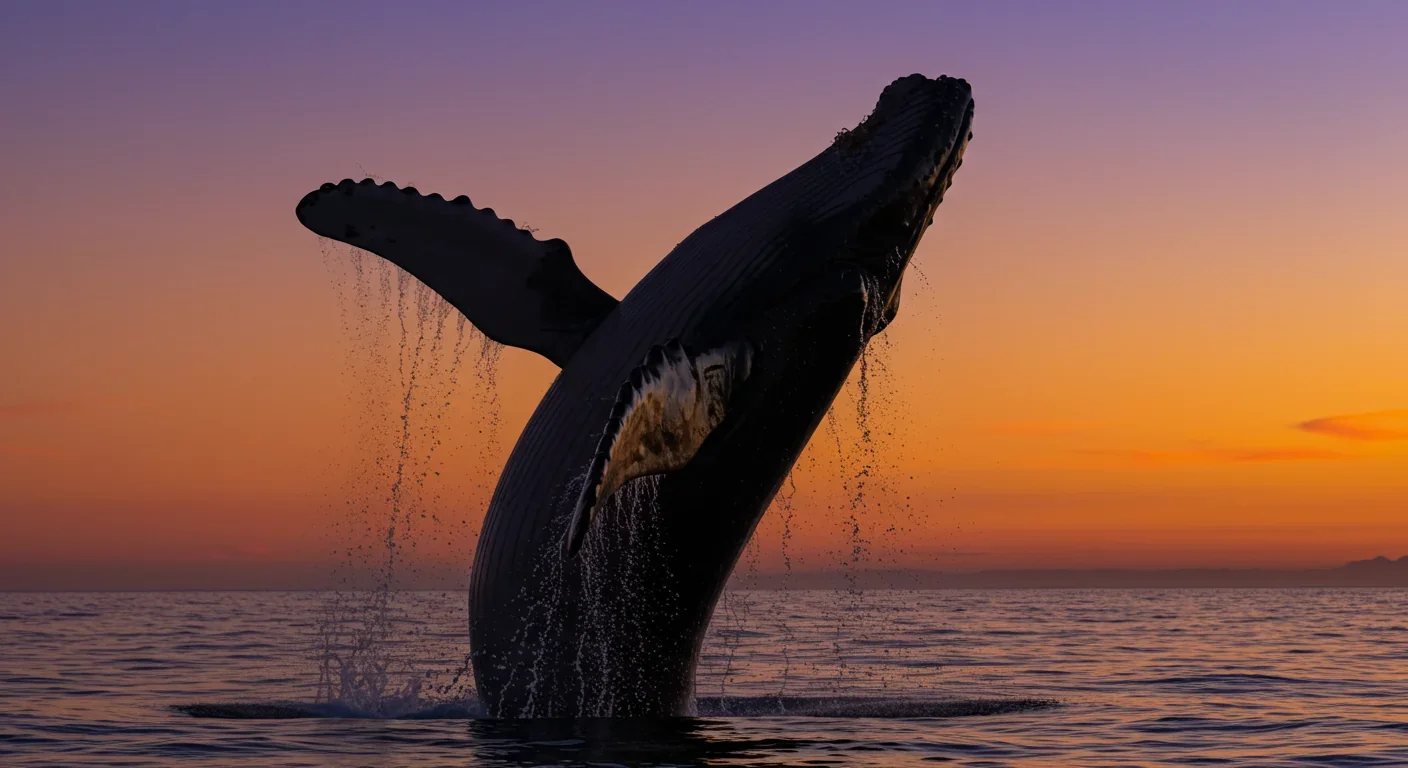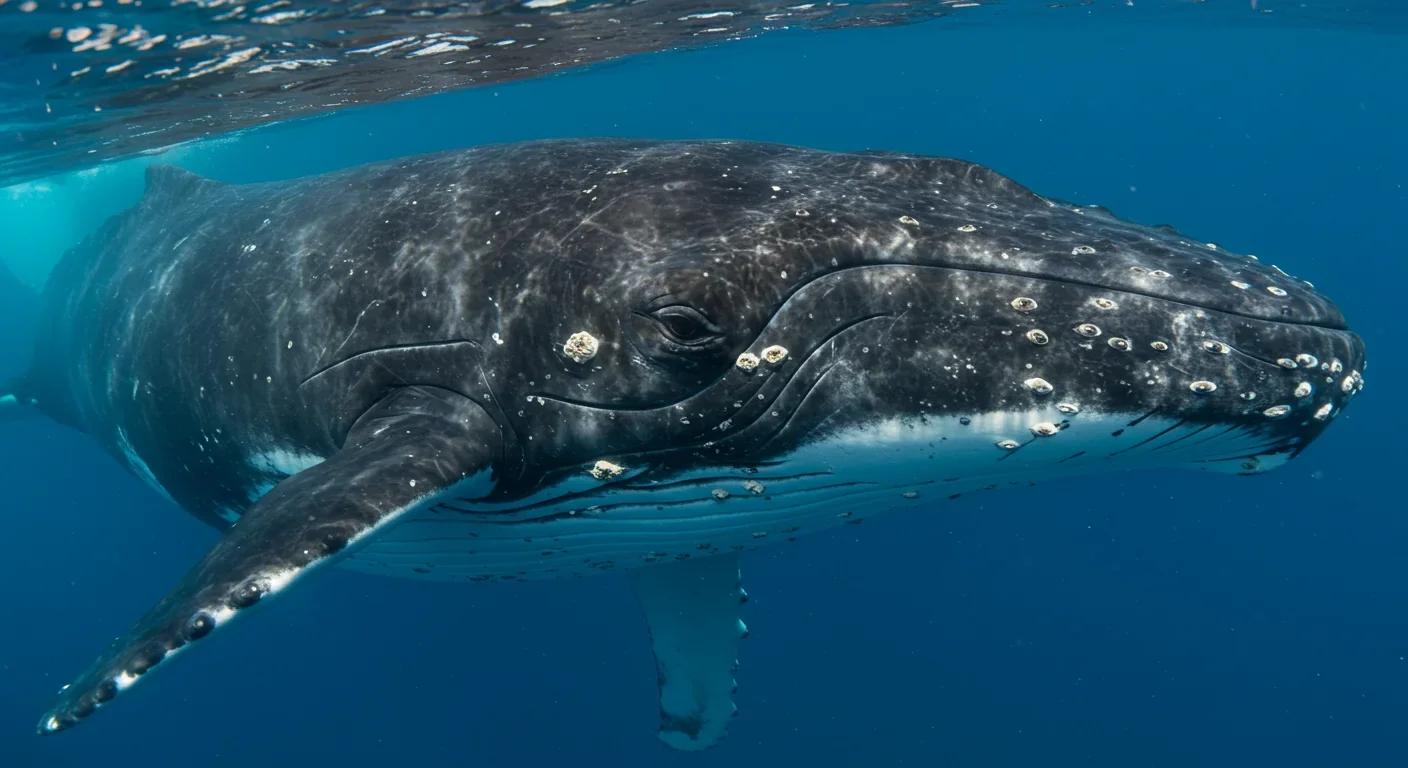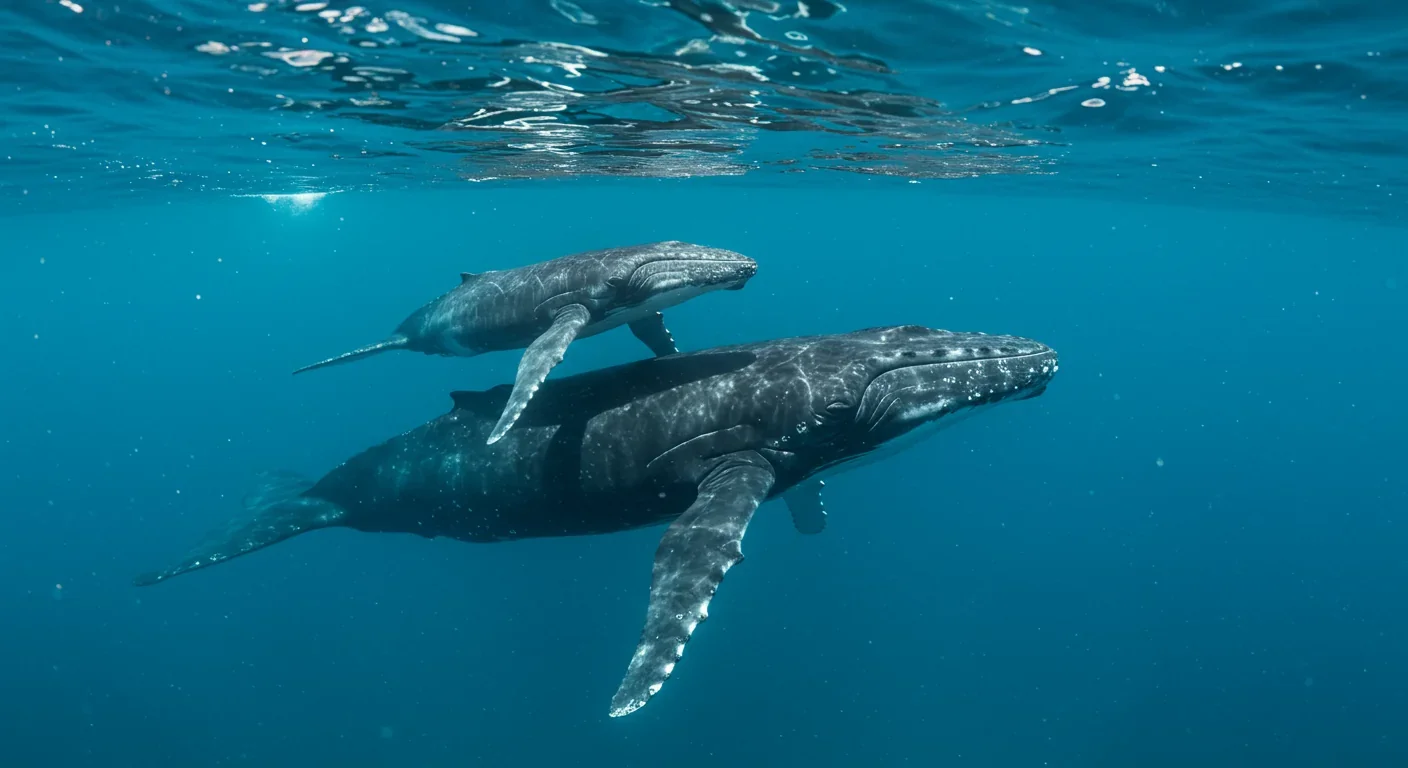Bombardier Beetle Chemical Defense: Nature's Micro Engine

TL;DR: Scientists are exploring whether whale songs culturally transmitted across generations trigger epigenetic modifications that reshape brain structure. This groundbreaking hypothesis suggests culture literally rewrites biology.

Imagine if the songs your grandmother sang could change the structure of your brain, not through memory or nostalgia, but by literally altering how your genes express themselves. That's not science fiction anymore. Scientists are uncovering evidence that whale songs, passed down through generations like underwater folk ballads, might be doing exactly that: reshaping the biology of whales in ways we're only beginning to understand.
In February 2025, researchers published findings showing that humpback whale songs exhibit the same statistical patterns found in human language. They analyzed eight years of recordings using methods borrowed from studying how babies learn to talk. What they found was startling: whales organize their songs using rules eerily similar to the ones governing how we speak.
But the implications go far deeper than linguistic parallels. This discovery opens a door to a radical hypothesis: could cultural transmission of whale songs trigger epigenetic modifications that affect brain structure across generations? Could culture literally rewrite biology?
To grasp what's happening here, you need to understand epigenetics, which is essentially how your genes get switched on or off without changing the DNA sequence itself. Think of your genome as a massive library. Epigenetics determines which books get read and which stay on the shelf.
DNA methylation, histone modifications, and non-coding RNA are the molecular bookmarks that make this happen. These markers can persist through cell division and, crucially, sometimes pass from parent to offspring. What you experience during your lifetime can leave molecular Post-it notes that your children inherit.
We've seen this in humans and other mammals. Stress, diet, trauma, even social experiences can create epigenetic changes that echo across generations. A 2022 study from UC Santa Cruz demonstrated that epigenetic memory can transmit across multiple generations in roundworms, with effects lasting up to 14 generations in some cases.
But here's where whales become fascinating: they're doing something mammals rarely do. They're learning complex vocalizations from each other and spreading those patterns across entire ocean basins.
Between 1995 and 1998, researchers documented something unprecedented: a completely new whale song swept across six humpback populations in the Pacific Ocean in a stepwise, eastward progression. Males from Australia to French Polynesia, spanning thousands of miles of ocean, abandoned their traditional songs and adopted the newcomer.
Think about that scale. This wasn't a small group picking up a catchy tune. This was population-wide cultural revolution, transmitted horizontally between populations that don't necessarily interact directly. Dr. Ellen Garland, who led the research, called it the first documented case of broad-scale, population-wide cultural exchange in any non-human species.
And here's the twist: male humpbacks are described as "open-ended learners," continuing to acquire new song elements throughout their entire lives. Unlike most mammals, which have critical periods for vocal learning that close in youth, whales keep their neural plasticity active for decades.
Humpback whales possess something remarkable: spindle neurons, also called von Economo neurons. Humans have them. Great apes have them. Elephants have them. These specialized brain cells are thought to play a role in social cognition, self-awareness, and complex communication.
But whales have something else we don't: they live in an acoustic world where sound travels four times faster than in air, where songs can propagate across hundreds of miles, where the primary way to navigate, hunt, socialize, and mate is through vocalization. Their brains are bathed in sound in ways ours never were.
Recent research on songbirds offers a tantalizing parallel. A 2021 study on zebra finches found that DNA methylation in song control regions of the brain increases progressively during development, with a distinct peak at the end of the critical learning period. The birds' genes were being chemically modified in response to vocal learning.
Could something similar happen in whales? Could the act of learning, performing, and transmitting complex songs create epigenetic signatures that affect how their brains develop?

Here's how it might work. When a young whale learns a song from adults, its brain undergoes intense neural activity in auditory and vocal control regions. That activity triggers molecular cascades: transcription factors get activated, chromatin structure changes, methyl groups attach to specific DNA sequences.
These epigenetic marks could influence which genes get expressed in brain tissue, potentially affecting everything from neuron density to synaptic connections to the production of neurotransmitters. Over time, if these modifications occur consistently enough and in germ cells (sperm and eggs), they could be passed to offspring.
The result? Each generation inherits not just the potential to learn songs, but a brain structure optimized for the specific acoustic patterns their culture transmits. Biology adapts to culture, which shapes biology, in a feedback loop spanning generations.
Sound far-fetched? Consider this: a 2024 study on grand-dam stress in rats showed that early-life stress experienced by grandmothers transmitted through paternal gametes, affecting social cognition in grandchildren. The mechanism? Epigenetic modifications to sperm cells.
If stress can do it, why not song?
What makes whale song particularly intriguing is its structural complexity. When researchers applied statistical methods used to study how infants segment speech, they discovered that whale songs follow Zipf's law, a mathematical pattern found in all human languages. The most common song elements appear at predictable frequencies, creating the same skewed distribution you see in English words.
But unlike human language, whale songs don't carry semantic meaning, at least not in ways we can detect. They're more like music, or poetry, patterns of sound that convey something through structure and repetition rather than through vocabulary.
This means whatever cognitive processes support whale song aren't necessarily the same as human language. They're parallel solutions to similar problems: how to create complex, socially transmitted acoustic signals that can vary while maintaining recognizable structure.
And that parallel evolution might be creating parallel epigenetic pressures. Just as enriched environments create epigenetic changes that enhance learning and protect against neurodegeneration in mammals, perhaps the acoustically rich environment of whale culture creates its own epigenetic landscape.
So how would scientists actually test this? How do you detect epigenetic modifications in creatures that live in the ocean and can weigh 40 tons?
The toolkit exists, though applying it to whales is challenging. Researchers can use bisulfite sequencing to map DNA methylation patterns across the genome. They can employ ChIP-seq to identify histone modifications. They can profile non-coding RNA through RNA-seq to see which regulatory molecules are active.
The challenge is getting tissue samples, especially brain tissue, from enough individuals across different populations to make meaningful comparisons. Researchers have used skin biopsies from living whales, which can provide DNA for methylation analysis. Brain tissue typically comes from stranded or deceased whales, which limits sample sizes.
But the field is advancing. A 2022 meta-analysis of animal vocal learning examined 610,000 recorded vocal elements from 16 species across 24 studies. As datasets grow larger and methods become more sophisticated, patterns that were invisible become clear.
There's also comparative evidence. Killer whales, close relatives of humpbacks, can learn to mimic dolphin calls when housed together, demonstrating remarkable vocal plasticity. Studying epigenetic differences between killer whale populations with different vocal dialects could provide clues.

If cultural transmission of whale songs really does induce epigenetic changes affecting brain structure, the implications are profound. It would mean whales are experiencing a form of evolution that operates on a much faster timescale than traditional natural selection.
Genetic mutations take many generations to spread through a population. Epigenetic modifications can potentially arise in a single generation and propagate quickly if they're beneficial. Cultural innovations like new songs could drive biological changes within decades rather than millennia.
This would make whales a living laboratory for understanding how culture shapes biology, a question central to human evolution. Our brains tripled in size over a few million years, an evolutionary sprint by mammalian standards. Language, art, ritual, social learning; did these cultural forces create epigenetic pressures that accelerated our neurological development?
Whales might be doing something similar, right now, in the ocean depths.
Of course, this hypothesis remains largely speculative. We don't yet have direct evidence of song-induced epigenetic modifications in whales. We don't know if such modifications, if they exist, persist across multiple generations or fade after a few. We don't know how specific they are—do different songs create different epigenetic signatures?
Some epigenetic changes are erased during germ cell formation and embryonic development, a process called epigenetic reprogramming. Many marks that seem heritable in one generation disappear in the next. For transgenerational inheritance to occur, modifications must escape this erasure, which happens but isn't common.
There's also the question of mechanism. What exactly about song learning would trigger epigenetic changes? Is it the acoustic stimulation? The social context? The motor patterns of vocalization? The cognitive effort of memorization and improvisation?
And perhaps most intriguingly: are whales aware, in any sense, that they're reshaping their own biology? Do they have cultural traditions around song transmission because it feels important, creates social cohesion, or is attractive to mates—reasons that have nothing to do with genetics—but unknowingly trigger biological changes in the process?
Understanding the biological impact of cultural transmission has urgent practical implications. Whale populations worldwide have been decimated by hunting, pollution, ship strikes, and climate change. When a population shrinks, it doesn't just lose individuals; it loses cultural knowledge.
If songs carry epigenetic significance, if they shape brain development in ways that persist across generations, then the loss of song diversity could have biological consequences we haven't appreciated. Populations that lose their vocal traditions might be losing more than culture; they might be losing adaptive neural architectures tuned to their specific environments.
This adds another dimension to conservation efforts. Protecting whales means protecting not just their numbers but their acoustic environments, their opportunities for cultural transmission, the social structures that allow young whales to learn from elders.
It also suggests that reintroduction efforts should consider cultural factors. If you're trying to rebuild a whale population, you might need to ensure that individuals carry the appropriate song traditions, or can learn them from surviving populations, to give offspring the best chance at neurological development.
This isn't just about cetaceans. If culture can induce heritable epigenetic changes in whales, it could happen in any species with complex learned behaviors. Songbirds. Primates. Elephants. Possibly humans.
Consider the diversity of human language, music, ritual across cultures. Could centuries of linguistic patterns, of particular musical scales, of rhythmic traditions, have left epigenetic fingerprints on populations? Could the languages we speak shape not just how we think, but how our brains physically develop, in ways that echo into future generations?
Some researchers are already exploring this. Studies on epigenetics of anxiety and stress-related disorders suggest that trauma and social environment create lasting biological changes. The field of cultural neuroscience examines how cultural practices influence brain structure.
Whale songs might be an extreme, concentrated example of something happening all around us: the feedback loop between what we learn, what we transmit, and what we become.
Here's what we know for certain: whales learn songs from each other. Those songs spread across populations in waves of cultural change. Whales have brains capable of sophisticated social cognition. Epigenetic inheritance is real, documented in many species. Cultural experiences can trigger epigenetic modifications.
What we don't know yet is whether all these pieces connect the way the hypothesis suggests. That's why researchers are pursuing it, designing studies, seeking funding, collecting samples from whale populations worldwide.
In the meantime, the ocean continues its ancient rhythms. Male humpbacks keep singing, learning new phrases from neighbors, abandoning old traditions for new ones. Calves swim alongside mothers, soaking in sounds that have traveled across an ocean, patterns that might be writing instructions into their developing brains.
And we listen, straining to hear not just the songs themselves, but what they might be saying about the nature of inheritance, about how culture becomes biology, about the ways life writes its own code.
Because if whale songs really are rewriting genetic blueprints, then every breach, every dive, every note echoing through the deep is part of a story much older and stranger than we imagined. A story where the line between learned and innate, between culture and nature, dissolves into the blue depths where the singers dwell.
The whales might not know they're conducting an evolutionary experiment. But they're singing anyway, as they have for millions of years, shaping not just the ocean soundscape but potentially themselves, one note at a time.

Recent breakthroughs in fusion technology—including 351,000-gauss magnetic fields, AI-driven plasma diagnostics, and net energy gain at the National Ignition Facility—are transforming fusion propulsion from science fiction to engineering frontier. Scientists now have a realistic pathway to accelerate spacecraft to 10% of light speed, enabling a 43-year journey to Alpha Centauri. While challenges remain in miniaturization, neutron management, and sustained operation, the physics barriers have ...

Epigenetic clocks measure DNA methylation patterns to calculate biological age, which predicts disease risk up to 30 years before symptoms appear. Landmark studies show that accelerated epigenetic aging forecasts cardiovascular disease, diabetes, and neurodegeneration with remarkable accuracy. Lifestyle interventions—Mediterranean diet, structured exercise, quality sleep, stress management—can measurably reverse biological aging, reducing epigenetic age by 1-2 years within months. Commercial ...

Data centers consumed 415 terawatt-hours of electricity in 2024 and will nearly double that by 2030, driven by AI's insatiable energy appetite. Despite tech giants' renewable pledges, actual emissions are up to 662% higher than reported due to accounting loopholes. A digital pollution tax—similar to Europe's carbon border tariff—could finally force the industry to invest in efficiency technologies like liquid cooling, waste heat recovery, and time-matched renewable power, transforming volunta...

Humans are hardwired to see invisible agents—gods, ghosts, conspiracies—thanks to the Hyperactive Agency Detection Device (HADD), an evolutionary survival mechanism that favored false alarms over fatal misses. This cognitive bias, rooted in brain regions like the temporoparietal junction and medial prefrontal cortex, generates religious beliefs, animistic worldviews, and conspiracy theories across all cultures. Understanding HADD doesn't eliminate belief, but it helps us recognize when our pa...

The bombardier beetle has perfected a chemical defense system that human engineers are still trying to replicate: a two-chamber micro-combustion engine that mixes hydroquinone and hydrogen peroxide to create explosive 100°C sprays at up to 500 pulses per second, aimed with 270-degree precision. This tiny insect's biochemical marvel is inspiring revolutionary technologies in aerospace propulsion, pharmaceutical delivery, and fire suppression. By 2030, beetle-inspired systems could position sat...

The U.S. faces a catastrophic care worker shortage driven by poverty-level wages, overwhelming burnout, and systemic undervaluation. With 99% of nursing homes hiring and 9.7 million openings projected by 2034, the crisis threatens patient safety, family stability, and economic productivity. Evidence-based solutions—wage reforms, streamlined training, technology integration, and policy enforcement—exist and work, but require sustained political will and cultural recognition that caregiving is ...

Every major AI model was trained on copyrighted text scraped without permission, triggering billion-dollar lawsuits and forcing a reckoning between innovation and creator rights. The future depends on finding balance between transformative AI development and fair compensation for the people whose work fuels it.